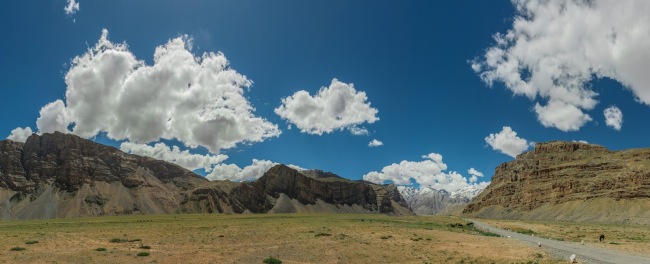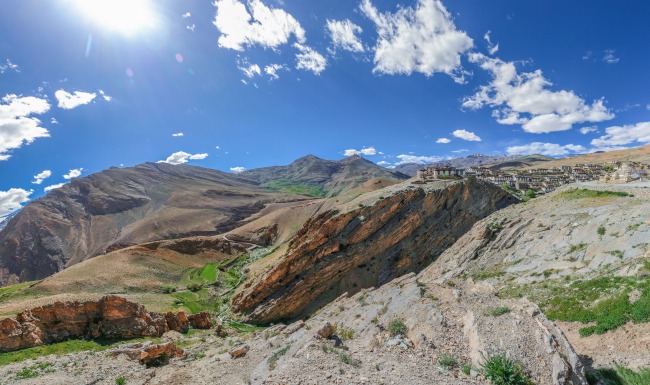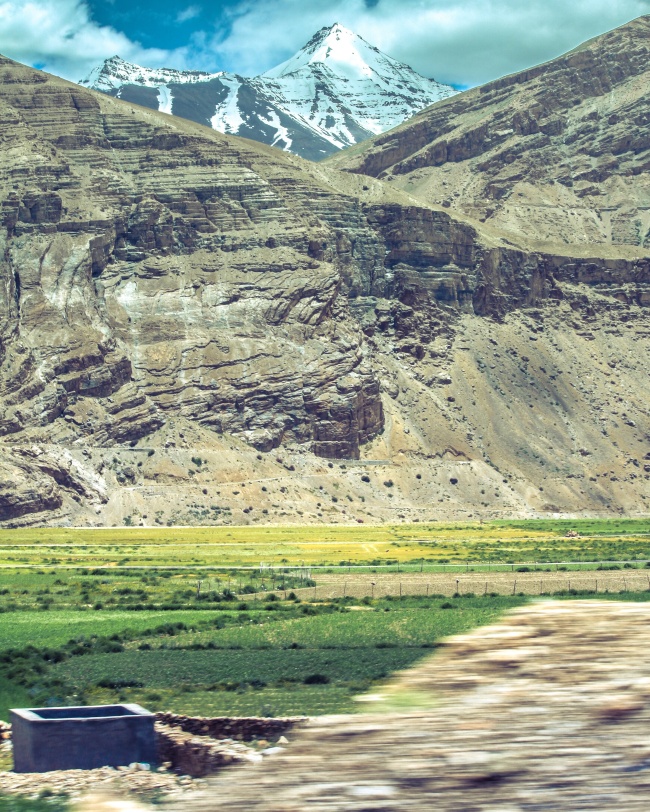Picking up from where I had ended the part 1 of the Himachal trip.. We had just completed the trek, had crossed the Hampta Pass a day earlier, and had reached Chattru. If we’d have gone for a standard trek package, we’d have ended our trek here and next step would be to head back to Manali. Some trek packages now extend the trip by a day and that’s what our arrangement was.. to drive till Chandratal from Chattru, camp there overnight with the Cub camper trailers and then return back to Manali the next day.
Errr, but we didn’t want to brakes so soon, hoping that now that we’re officially in Spiti Valley and just a few hours of drive away from Kaza, why not extend our stay for a day. We didn’t know this at the time of booking but the group that had originally booked with Ronnie had planned to extend the trip further to Spiti Valley. These guys had already reserved a cab that had come to pick us for the roadtrip, sweet! These customization are only possible when you book with a local guide, for the organized players wouldn’t be able to accommodate any changes in their packed schedule. The big groups have back to back batches of trekking groups crossing the pass, remember we’re doing one of the most famous treks in Himalayas! If you haven’t heard of Spiti Valley, then a trip is highly recommended, for you’d find yourself on roads like these!
While planning the trip, this possible extension to Spiti Valley had really stressed me out and I wasn’t sure if we’d be able to pull it off. If you’d ask me now, there wasn’t much we could have done to plan it out better, if you’re going to a place as remote as Spiti, expect things to not go as smoothly as planning a roadtrip to Goa. There was a lot of uncertainty about whether the road from Manali to Kaza had opened for the season or not. Unfortunately there is no reliable source, public or private, that publishes status of that road and the route is prone to landslides, thus there is always a risk associated with this trip.
Our original plan was to board the bus heading towards Kaza from Batal, if we’d reach Batal before the bus. The back-up plan was to stay back at Batal and find a shared taxi that had space for us. Worst case scenario, we’d have to stay the night and wait for the bus that’d be passing Batal next morning as there is just a single bus that leaves for Kaza from Manali in a day. I had made several phone calls to get confirmation on operations of the public bus service that runs from Manali to Kaza but I got so many conflicting replies that I had put it off to be figured at Manali bus stand itself. In hindisght, I was being really optimistic about our chances of finding some means of reaching Kaza from Chandratal. I’d recommend not to rely on finding something mid-way, finding a bus or a taxi from Manali wouldn’t be a challenge however.
So after this rather detailed note on how we figured out our travel logistics, time to move over to the journey itself. Our plan for the first day was to first drive to Batal, book the tents there for night stay. We opted to stay here rather than trying our luck at Chandratal as the few tents there are in high demand and it’d be hard to stay there unless you’ve booked weeks in advance. Then on the subsequent day, we’d start from Batal to reach Kaza by noon. This gave us a good day and a half window to explore the villages of Spiti, whichever ones are in vicinity of Kaza, the capital city where we’d be staying at night. If you’re wondering why we took so much pain to visit a few villages, it’s because of their remote locations! Look at one such village below and imagine the hike to the farms at the bottom of the valley, how does it compare with the choked roads in cities you take for your work commute.. pretty much!
This place deserves a separate trip for you need atleast a week to cover everything this place has to offer. We rushed there because of this being an extension of our main trip but this isn’t a place to go for just a check-in. So, what we did was a short trip, which a lot of people do when they don’t have 10 days to spare and/or are traveling from Manali. But, the best way to cover this region is to get on a motorbike (or a car if you find a bike too risky) and reach Shimla. The real trip starts from there, you’d be crossing Kinnaur and Spiti districts of Himachal to end the trip at Manali. I’ve mapped both the trip in the map below. If you haven’t used MyMaps by Google, you’d be able to see the menu, which allows you to turn on and off the layers on the map, by clicking the slider on top left. I’ve also mapped the 2 side trips that we did, I’m sure there are more that one can do, especially when you’re traveling from Shimla and have more time on hand.
&amp;amp;amp;amp;lt;br /&amp;amp;amp;amp;gt;&amp;amp;lt;br /&amp;amp;gt;&lt;br /&gt;<br />
$(‘.myIframe’).css(‘height’, $(window).height()+’px’);
So, as per our plan, we started off for Batal after the lunch at Chattru but only to realize after a while that we’d only be driving on namesake roads. The roads till Batal are really rocky riverbeds that have now dried up except for occasional streams that still were flowing at times through the road to join the bigger Chandra river. A few other times, the streams were the roads! Yes, at times, we were literally going upstream for a few hundred meters, nothing too dangerous, just adventurous! I wasn’t clicking these pictures because the road was super bumpy for any sort of camera setting and we didn’t have enough time to stop for shooting other cars.
Batal, much like Chattru, is not really a village but more like a settlement besides another bridge on the Chandra river. However, the one thing that stood out for me was the Dhabha there run by an elderly couple, lovingly called Chacha Chachi and even the dhabha is more popularly called Chacha Chachi Dhabha. They have an interesting story to say the least. They have been running the eating joint for decades at prices that beat your expectations, given the hostility of the environment there. They are not money-minded people and you’d always feel warmth in their tents and in their hearts. But more interestingly, so far they’ve rescued more than a hundred travelers who at multiple occasions got stuck in the heavy snow there. In 2013, they were recognized by the Himachal Government for their bravery and service to the people.
Soon after, we reached the sublime lake hidden in the mountains – Chandratal. The spot has become really popular off late and and a lot of permanent camps have been setup for the incoming tourists. However the government is growing strict with these developments and now the tents are pitched at about 3km before the lake. You’d still be able to drive for 2 more kms and the lake then remains less than a km of hike away. But from what I heard, the government would soon close the road beyond the camps and the only option to reach the lake would be to hike from the camps. Everyone had been waiting for this leg of the trip and no one seemed to mind the short hike to the lake. Below is the first view we got of the lake!
Also, it was rather windy that day and the dry wind would cut through your skin, but still sunny enough to burn your skin. Spiti valley is known for its extreme weather. Also, this lake is at the elevation of 4300m, higher than the pass we had crossed. Thus I could feel the high altitude acting. I was feeling a bit funny in my head and my nose never stopped dripping there. But that didn’t stop me or even others in getting clicked against the lake!
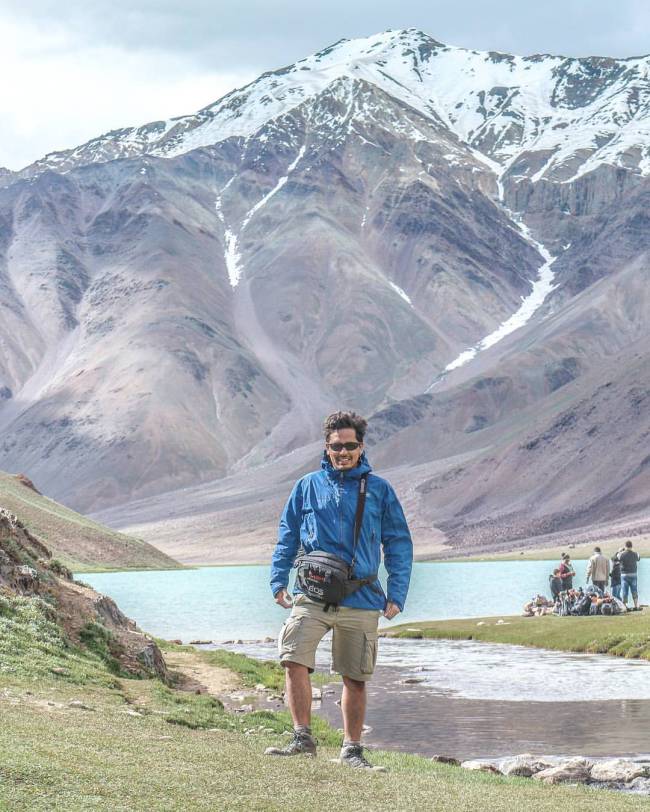
I had planned to click the iconic shot to get the reflections of the mountains in the lake, but because of the wind, the water had turned wavy and I guess i’ll have to come back for the shot that inspired me to get here..
Although I would have loved to stay longer at the lake, explore the surrounding hills, we had to return back to Batal where we were sleeping that night. The night stay was fun, especially after 3 nights of camping in tents where I couldn’t really fit. We started next day with paranthas at the dhabha and bid farewell to Ronnie who was returning to Manali. He had gone beyond the call of duty to make sure our stay at Batal was comfortable and was inclined to come back for Pin Parvati trek with his group, once I am fit and ready for it.
To reach Kaza, we had to cross the Kunzum Pass, which is a motorable pass at an elevation of 4500m. The namesake cafe in Delhi has contributed to the popularity of this pass as this is the gateway to Spiti when you’re travelling from Manali. You’d find a small temple at the top and is customary to halt here. We did too, even when we were returning 2 days later.
We’d be entering the heart of the Spiti Valley from here onwards and I had some ideas of the views from the hours of browsing on internet. I got the below shot from the moving taxi and we later drove on the same road! Imagine the shots you can create if you have the luxury to stop at each turn!
Kaza is the capital city of the Spiti district and given the recent love for the region, a mad rush has gripped the city to open new hotels to accommodate the growing number of tourists. We had to scout for rooms through the city and found some arrangement at a place called Winter White. I’d recommend booking for hotels in advance there since your phones won’t be working and it can get a bit tiring to knock on hotel doors asking for rooms in the peak summer season. We never reached a vantage point to click a similar photo of the city, but imagine Kaza to be another such village, only much bigger.

This post is not just about the journey, we do arrive somewhere, haha! We only had a about 3 hrs of sunshine left for the day and decided to split our side trip into 2 parts, visit Key monastery and Kibber village today and figure out the rest of the places the next day, which ones were still up for discussion!
Although we visited Kibber village first but I’ll talk about it with other villages we visited the next day, let’s have a look at the Key Monastery first. If you knew about Spiti Valley from internet, then you’d surely know about the landmark that is Key Monastery. It is the largest in the valley and sits atop a hill in the shadow of rocky mountains overlooking the Spiti River. I had clicked the shot below from the other side of the river.
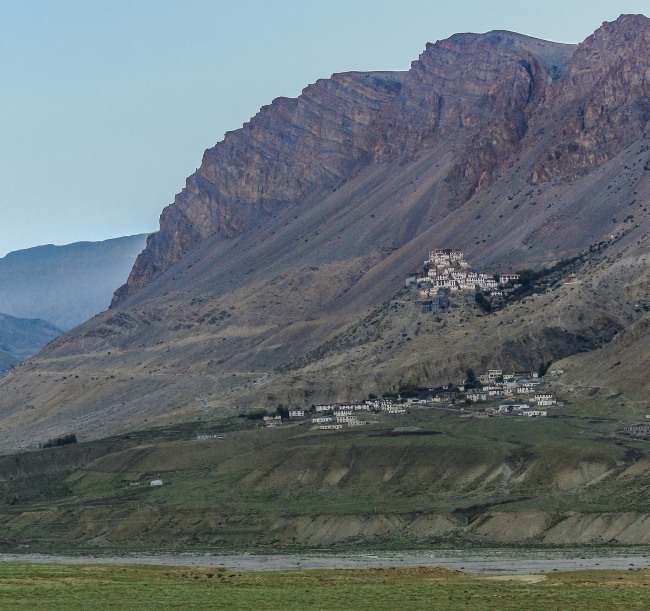
You might better recall it from the ever famous shot below, you too can click it from a vantage point, somewhere on the rocky mountains you see behind the monastry. You’d see a trail that leads to that spot, go for it if you have the time and courage! But you’d have to shoot it early in the morning as the sun sets across the river and you’d get a backlit shot with flares if you’d try your luck post noon.
I still got a few good shots though, looking at the valley from the monastery. Unfortunately the monastery was closed and we could just roam around the main prayer halls, trying to understand as much as we could about this foreign land in the limited time for which we were there.
We spent the following evening at the Himalayan Cafe, which seemed to be the most popular eating joint at the Kaza market. I personally liked the food and the hip ambiance they had managed to create. By now we had spent close to a week without phone connectivity and the only little internet that Kaza gets is through BSNL tower in the city. The WiFi connectivity is rather poor and keeps everyone on the leash by connecting intermittently every few minutes. Ashamed to admit it but that’s what we all were busy doing that evening post dinner, hoping to connect back with life back home.
If you’d look at the map I had posted above, the side trip from Kaza took us to nearby villages which offer a glimpse into the life of people who live disconnected from world hidden in the remotest corners of the country. The roads to these villages remain closed during the winters and the only source of income for these people is the little farming they manage to do at relatively flat stretches of lands close to their homes. We had covered Kibber the previous day and next day we drove on the closed loop that brought us to 4 more villages – Langcha, Hikkim, Komik and Demul, listed in same order we reached these places, starting and ending our trip at Kaza. Each of these places were memorable in their own ways –
- Langcha is known for fossils, yes! Evidently the region was full of marine life, some millions of years ago. You can trek ahead of the village to hunt them down yourself or you’d surely encounter kids, at the village, who’d be selling them in all shapes and price ranges. It’s a great place for hunting.
- Hikkim has the honour of having the highest post-office in the world. You’d see a lot of people visiting the place getting themselves clicked against the Indian Post Office building there and sending out postcards to friends, which take upto 20 days to deliver.
- Komik was once the highest motorable village in the world, there is a sign that still says so, but if you’d try researching this on internet, you’d see this claim doesn’t hold true anymore.
- Demul doesn’t have an unique feature that puts it in the spotlight but it was the remotest place we had been to. I found it to be the most serene, with just a bunch of neatly packed white houses nestled in the lap of nature.
We drove through picturesque valleys on roads that rarely I really enjoyed clicking most of these shots, especially the landscape panoramas! It’s always tricky to decide how many photos to include, where to crop to balance the trade-off between the wide-angle view, what you really are seeing and the aspect ratio of final image, the curvature of horizons. The kids here seemed hardened by the extreme weather of Spiti, the one selling the fossils could negotiate really well!
Another thing that I’d like to mention is the we were lucky to locate a couple of what seemed like wild deers, called Bharal in Hindi, and for some odd reason, Blue Sheep in English. They usually graze away from villages during summers, and come down to villages only during winters. Snow Leapords prey on these wild folks, thus, if you want to spot these big cats, then it’d be a good idea to plan a photography trip to Kaza during winters. Even if you don’t spot a leapord, you’d have booked a trip for the wonderland, so it’s definitely a good deal!

Everyone seemed happy with the day, it was relaxed and easy paced. Even though we drove through bumpy roads, nobody was complaining about it on our return journey to Kaza and kept bringing up the stories and memories we had created earlier in the day. We had a rather filling dinner at the hotel, and even some Old Monk we had managed to source from the wine shop at the market, tee hee! 😀
The whole of next day was spent in coming back to the cities where we had to re-join our daily lives. The drive to Manali from Kaza is 12 hrs long and we just had a couple of hours of stop there before we boarded our bus for Delhi, a back breaking 16 hrs journey. I remember not doing much on the ride back. I had loaded up the phone with netflix shows and new music but I guess I just wanted a clear mind, much like the Spiti roads that had brought us to the lovely villages. One thing that I did do was review all the photos, here is the full album for with more shots that didn’t make it to this post.
Well, this was my super trip! Do share your Spiti stories as well and if you haven’t been there, I hope this post could be of some help to you..

